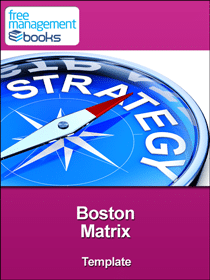
Boston Matrix Template
This Boston Matrix template allows you to record your relative market share and growth for each of your products and services helping you to identify the strengths and weaknesses of your portfolio.
The Boston Matrix was developed in 1970. It is used to understand and determine the growth or lack of growth of a product. While the Boston Matrix can be a useful tool for analysis, it is also a technique that is highly criticized throughout the marketing community.
What is the Boston Matrix?
The Boston Matrix uses a four-celled matrix made up of “Stars”, “Cash Cows”, “Questions Marks”, and “Dogs” that sit on two axes: “Market Growth” and “Market Share”. Market shares and growth rates of a business product or service are then plotted onto this matrix.
A Cash Cow does not mean you don’t have to spend money to maintain its status.
An assumption the Boston Matrix uses is that when a product has reached Cash Cow status that you will have to spend less money on this product and that your investments into this product will have been paid back. This is usually not true because to keep a product as being viewed as a market leader you will have to spend money to maintain the value of the brand. Keeping up with the brands reputation is a constant ongoing endeavor.
Is a “Dog” always a bad idea?
Many people do not like the term “Dog” that is used when discussing a product that is low on profitability. A “Dog” product is viewed in a negative light because it is not as profitable as a “Cash Cow”. Sometimes companies continue to produce a “Dog” product because of the profit that is accrued with its maintenance. For instance, a company may produce a product that breaks even because when the customer uses the “Dog” product they have to spend more money to operate it, which is high in profit.
Another limitation of the Boston Matrix is simply its age.
The Boston Matrix came to be in 1970. Let’s face it, many things have changed since 1970. Over the last 43 years the economy has drastically changed. The way that companies analyze their financial situations and investments have dramatically changed since the birth of the Boston Matrix.
What was the Boston Matrix really intended to do?
People often misuse the Boston Matrix simply because they are unaware of how it was intended to be used. Some people want to use it make major decisions at brand level when it was really meant to be used as a tool to guide decisions on how to distribute money across the divisions of a company.
Yet another misconception
Just because market share is high does not mean that your profit is going to be high. The Boston Matrix is incorrect in believing that this is always true.
Sometimes being more complex really is better.
Another notable limitation of the Boston Matrix is that it is often viewed by many as being too simplistic. When dealing with an extremely complex company, a simple four-cell matrix is not going to get the job done. There are many factors and variables that need to be taken into consideration when completing an analysis that the Boston Market simply does not take into consideration.
Is the Boston Matrix a technique you should use?
Although the Boston Matrix has been a valuable tool for marketers for the last 43 years, it recently is losing steam throughout the education community. Some modern curriculums have decided to discontinue education of students to this technique because of its limitations. If used correctly this can be an effective analysis tool. You must be aware of its limitations before putting this technique to use. Do your research before deciding if this is the best tool for you. There are numerous resources available including our free eBook that will give you even more insight into this technique.
